Dustin Schwenk
2 OLMo 2 Furious
Dec 31, 2024
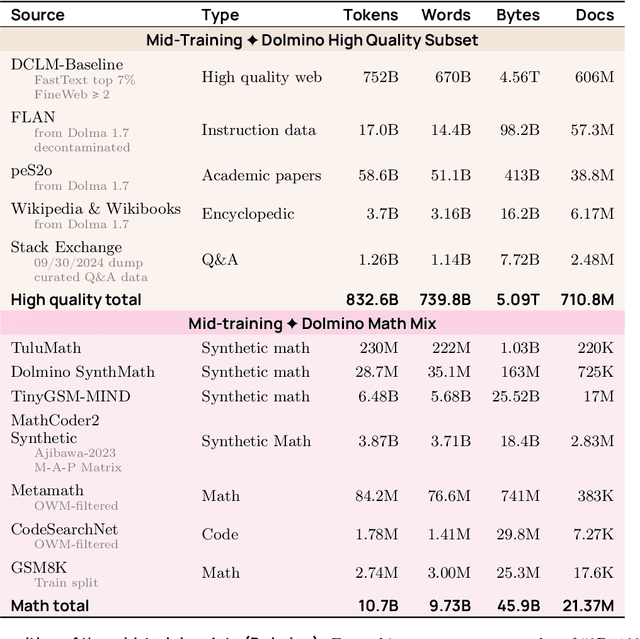
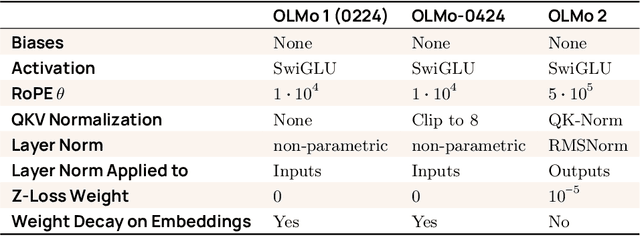

Abstract:We present OLMo 2, the next generation of our fully open language models. OLMo 2 includes dense autoregressive models with improved architecture and training recipe, pretraining data mixtures, and instruction tuning recipes. Our modified model architecture and training recipe achieve both better training stability and improved per-token efficiency. Our updated pretraining data mixture introduces a new, specialized data mix called Dolmino Mix 1124, which significantly improves model capabilities across many downstream task benchmarks when introduced via late-stage curriculum training (i.e. specialized data during the annealing phase of pretraining). Finally, we incorporate best practices from T\"ulu 3 to develop OLMo 2-Instruct, focusing on permissive data and extending our final-stage reinforcement learning with verifiable rewards (RLVR). Our OLMo 2 base models sit at the Pareto frontier of performance to compute, often matching or outperforming open-weight only models like Llama 3.1 and Qwen 2.5 while using fewer FLOPs and with fully transparent training data, code, and recipe. Our fully open OLMo 2-Instruct models are competitive with or surpassing open-weight only models of comparable size, including Qwen 2.5, Llama 3.1 and Gemma 2. We release all OLMo 2 artifacts openly -- models at 7B and 13B scales, both pretrained and post-trained, including their full training data, training code and recipes, training logs and thousands of intermediate checkpoints. The final instruction model is available on the Ai2 Playground as a free research demo.
OLMoE: Open Mixture-of-Experts Language Models
Sep 03, 2024



Abstract:We introduce OLMoE, a fully open, state-of-the-art language model leveraging sparse Mixture-of-Experts (MoE). OLMoE-1B-7B has 7 billion (B) parameters but uses only 1B per input token. We pretrain it on 5 trillion tokens and further adapt it to create OLMoE-1B-7B-Instruct. Our models outperform all available models with similar active parameters, even surpassing larger ones like Llama2-13B-Chat and DeepSeekMoE-16B. We present various experiments on MoE training, analyze routing in our model showing high specialization, and open-source all aspects of our work: model weights, training data, code, and logs.
OLMo: Accelerating the Science of Language Models
Feb 07, 2024
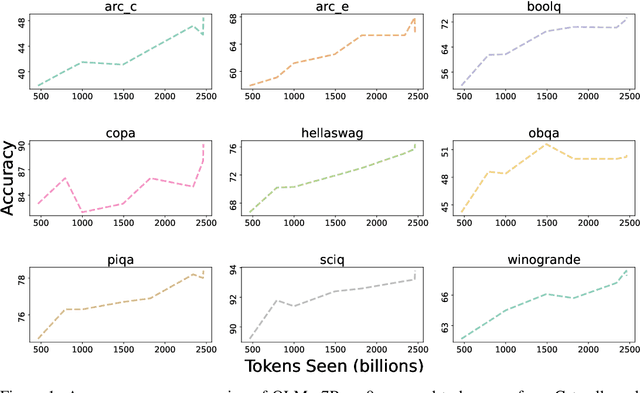
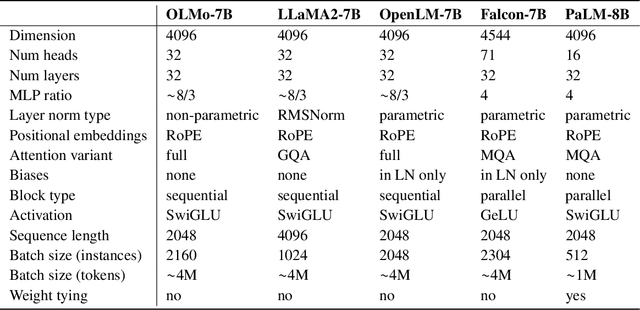
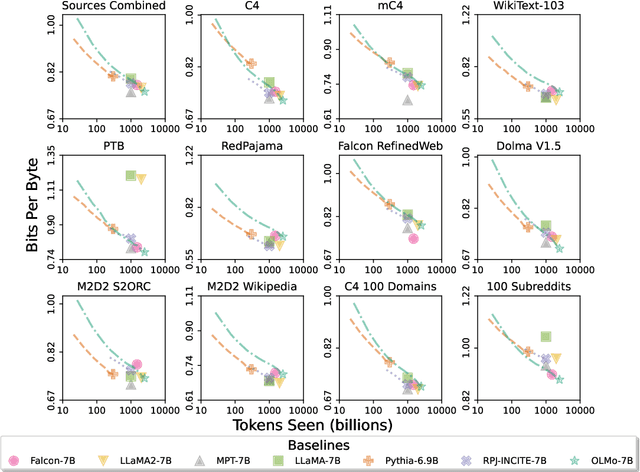
Abstract:Language models (LMs) have become ubiquitous in both NLP research and in commercial product offerings. As their commercial importance has surged, the most powerful models have become closed off, gated behind proprietary interfaces, with important details of their training data, architectures, and development undisclosed. Given the importance of these details in scientifically studying these models, including their biases and potential risks, we believe it is essential for the research community to have access to powerful, truly open LMs. To this end, this technical report details the first release of OLMo, a state-of-the-art, truly Open Language Model and its framework to build and study the science of language modeling. Unlike most prior efforts that have only released model weights and inference code, we release OLMo and the whole framework, including training data and training and evaluation code. We hope this release will empower and strengthen the open research community and inspire a new wave of innovation.
Dolma: an Open Corpus of Three Trillion Tokens for Language Model Pretraining Research
Jan 31, 2024



Abstract:Language models have become a critical technology to tackling a wide range of natural language processing tasks, yet many details about how the best-performing language models were developed are not reported. In particular, information about their pretraining corpora is seldom discussed: commercial language models rarely provide any information about their data; even open models rarely release datasets they are trained on, or an exact recipe to reproduce them. As a result, it is challenging to conduct certain threads of language modeling research, such as understanding how training data impacts model capabilities and shapes their limitations. To facilitate open research on language model pretraining, we release Dolma, a three trillion tokens English corpus, built from a diverse mixture of web content, scientific papers, code, public-domain books, social media, and encyclopedic materials. In addition, we open source our data curation toolkit to enable further experimentation and reproduction of our work. In this report, we document Dolma, including its design principles, details about its construction, and a summary of its contents. We interleave this report with analyses and experimental results from training language models on intermediate states of Dolma to share what we have learned about important data curation practices, including the role of content or quality filters, deduplication, and multi-source mixing. Dolma has been used to train OLMo, a state-of-the-art, open language model and framework designed to build and study the science of language modeling.
Paloma: A Benchmark for Evaluating Language Model Fit
Dec 16, 2023Abstract:Language models (LMs) commonly report perplexity on monolithic data held out from training. Implicitly or explicitly, this data is composed of domains$\unicode{x2013}$varying distributions of language. Rather than assuming perplexity on one distribution extrapolates to others, Perplexity Analysis for Language Model Assessment (Paloma), measures LM fit to 585 text domains, ranging from nytimes.com to r/depression on Reddit. We invite submissions to our benchmark and organize results by comparability based on compliance with guidelines such as removal of benchmark contamination from pretraining. Submissions can also record parameter and training token count to make comparisons of Pareto efficiency for performance as a function of these measures of cost. We populate our benchmark with results from 6 baselines pretrained on popular corpora. In case studies, we demonstrate analyses that are possible with Paloma, such as finding that pretraining without data beyond Common Crawl leads to inconsistent fit to many domains.
Imitating Shortest Paths in Simulation Enables Effective Navigation and Manipulation in the Real World
Dec 05, 2023



Abstract:Reinforcement learning (RL) with dense rewards and imitation learning (IL) with human-generated trajectories are the most widely used approaches for training modern embodied agents. RL requires extensive reward shaping and auxiliary losses and is often too slow and ineffective for long-horizon tasks. While IL with human supervision is effective, collecting human trajectories at scale is extremely expensive. In this work, we show that imitating shortest-path planners in simulation produces agents that, given a language instruction, can proficiently navigate, explore, and manipulate objects in both simulation and in the real world using only RGB sensors (no depth map or GPS coordinates). This surprising result is enabled by our end-to-end, transformer-based, SPOC architecture, powerful visual encoders paired with extensive image augmentation, and the dramatic scale and diversity of our training data: millions of frames of shortest-path-expert trajectories collected inside approximately 200,000 procedurally generated houses containing 40,000 unique 3D assets. Our models, data, training code, and newly proposed 10-task benchmarking suite CHORES will be open-sourced.
What's In My Big Data?
Oct 31, 2023
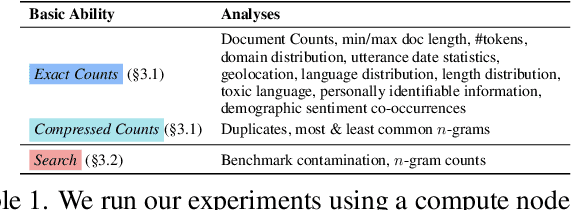


Abstract:Large text corpora are the backbone of language models. However, we have a limited understanding of the content of these corpora, including general statistics, quality, social factors, and inclusion of evaluation data (contamination). In this work, we propose What's In My Big Data? (WIMBD), a platform and a set of sixteen analyses that allow us to reveal and compare the contents of large text corpora. WIMBD builds on two basic capabilities -- count and search -- at scale, which allows us to analyze more than 35 terabytes on a standard compute node. We apply WIMBD to ten different corpora used to train popular language models, including C4, The Pile, and RedPajama. Our analysis uncovers several surprising and previously undocumented findings about these corpora, including the high prevalence of duplicate, synthetic, and low-quality content, personally identifiable information, toxic language, and benchmark contamination. For instance, we find that about 50% of the documents in RedPajama and LAION-2B-en are duplicates. In addition, several datasets used for benchmarking models trained on such corpora are contaminated with respect to important benchmarks, including the Winograd Schema Challenge and parts of GLUE and SuperGLUE. We open-source WIMBD's code and artifacts to provide a standard set of evaluations for new text-based corpora and to encourage more analyses and transparency around them: github.com/allenai/wimbd.
Objaverse: A Universe of Annotated 3D Objects
Dec 15, 2022Abstract:Massive data corpora like WebText, Wikipedia, Conceptual Captions, WebImageText, and LAION have propelled recent dramatic progress in AI. Large neural models trained on such datasets produce impressive results and top many of today's benchmarks. A notable omission within this family of large-scale datasets is 3D data. Despite considerable interest and potential applications in 3D vision, datasets of high-fidelity 3D models continue to be mid-sized with limited diversity of object categories. Addressing this gap, we present Objaverse 1.0, a large dataset of objects with 800K+ (and growing) 3D models with descriptive captions, tags, and animations. Objaverse improves upon present day 3D repositories in terms of scale, number of categories, and in the visual diversity of instances within a category. We demonstrate the large potential of Objaverse via four diverse applications: training generative 3D models, improving tail category segmentation on the LVIS benchmark, training open-vocabulary object-navigation models for Embodied AI, and creating a new benchmark for robustness analysis of vision models. Objaverse can open new directions for research and enable new applications across the field of AI.
A-OKVQA: A Benchmark for Visual Question Answering using World Knowledge
Jun 03, 2022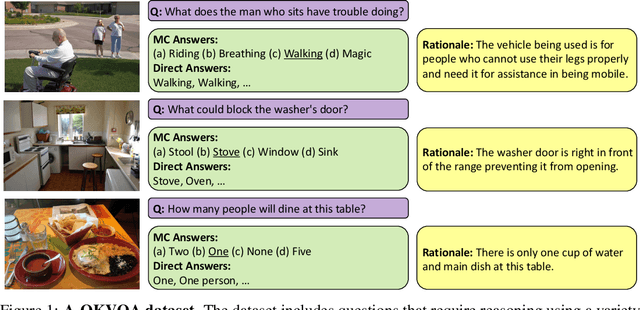

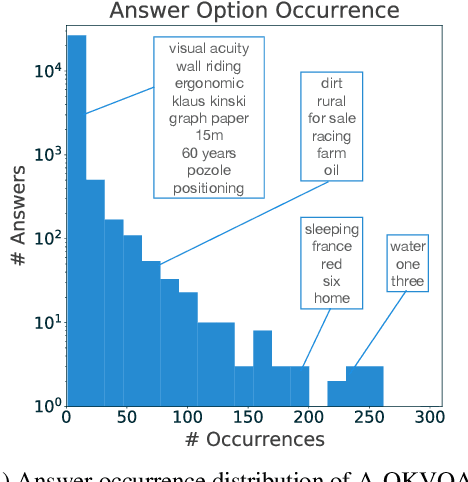
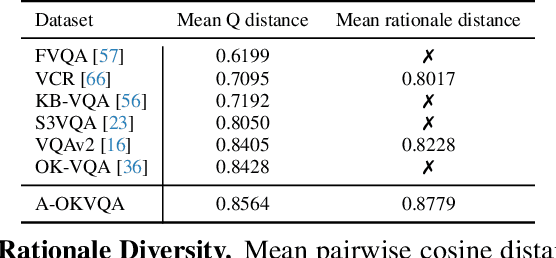
Abstract:The Visual Question Answering (VQA) task aspires to provide a meaningful testbed for the development of AI models that can jointly reason over visual and natural language inputs. Despite a proliferation of VQA datasets, this goal is hindered by a set of common limitations. These include a reliance on relatively simplistic questions that are repetitive in both concepts and linguistic structure, little world knowledge needed outside of the paired image, and limited reasoning required to arrive at the correct answer. We introduce A-OKVQA, a crowdsourced dataset composed of a diverse set of about 25K questions requiring a broad base of commonsense and world knowledge to answer. In contrast to the existing knowledge-based VQA datasets, the questions generally cannot be answered by simply querying a knowledge base, and instead require some form of commonsense reasoning about the scene depicted in the image. We demonstrate the potential of this new dataset through a detailed analysis of its contents and baseline performance measurements over a variety of state-of-the-art vision-language models. Project page: http://a-okvqa.allenai.org/
Iconary: A Pictionary-Based Game for Testing Multimodal Communication with Drawings and Text
Dec 01, 2021Abstract:Communicating with humans is challenging for AIs because it requires a shared understanding of the world, complex semantics (e.g., metaphors or analogies), and at times multi-modal gestures (e.g., pointing with a finger, or an arrow in a diagram). We investigate these challenges in the context of Iconary, a collaborative game of drawing and guessing based on Pictionary, that poses a novel challenge for the research community. In Iconary, a Guesser tries to identify a phrase that a Drawer is drawing by composing icons, and the Drawer iteratively revises the drawing to help the Guesser in response. This back-and-forth often uses canonical scenes, visual metaphor, or icon compositions to express challenging words, making it an ideal test for mixing language and visual/symbolic communication in AI. We propose models to play Iconary and train them on over 55,000 games between human players. Our models are skillful players and are able to employ world knowledge in language models to play with words unseen during training. Elite human players outperform our models, particularly at the drawing task, leaving an important gap for future research to address. We release our dataset, code, and evaluation setup as a challenge to the community at http://www.github.com/allenai/iconary.
 Add to Chrome
Add to Chrome Add to Firefox
Add to Firefox Add to Edge
Add to Edge